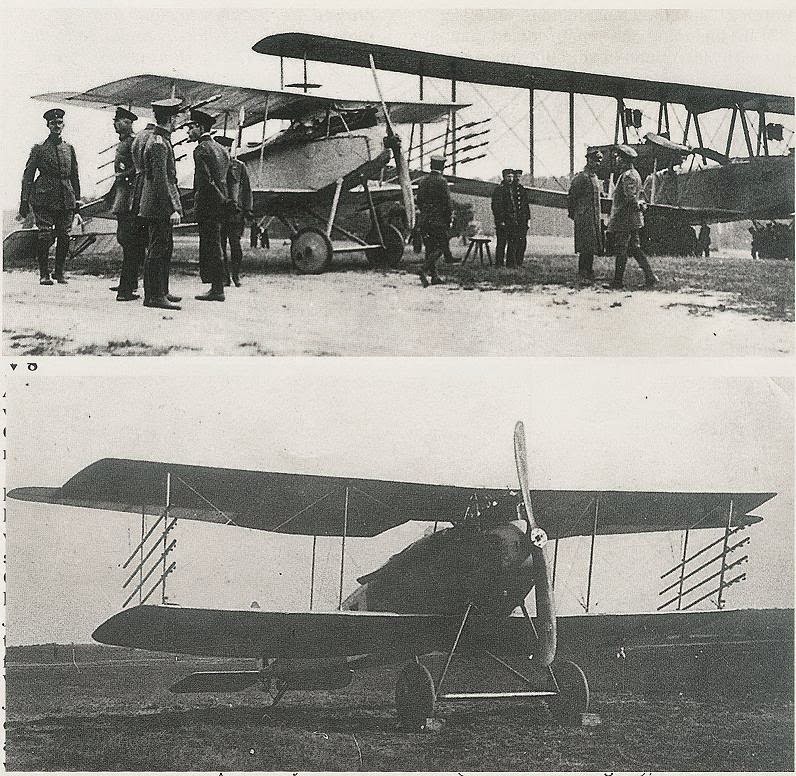In April 1916 the Le Prieur rocket – named after French Lieutenant (N) Yves Paul Gaston Le Prieur - was introduced against observation balloons in the skies above Verdun. The rocket was fired from aircraft such as the Nieuport fighters, SPAD VIIs and Sopwith Pups. The rockets were mounted at an upwards angle on the struts of the biplanes, and they were fired sequentially when the aircraft was diving towards the target. Each rocket contained 200 grammes of black powder, and the rockets were fired electrically at ranges between 100 and 150 meters. The accuracy was dismal, but the weapon was used until incendiary machine gun ammunition became available.
Firing a Le Prieur rocket. (www.dieselpunks.org/profiles/blogs/knights-of-the-air-le-prieur)
Le Prieur rockets mounted on a Nieuport at Cachy in 1916 (http://www.ctie.monash.edu.au/hargrave/le_prieur.html)
The Le Prieur rockets were, of course, noted by the Germans,
and future spaceflight pioneer Rudolf Nebel (March 21, 1894 – September 18,
1978) conducted experiments with a German version of an air-to-air rocket. Nebel,
who by the way has no connection with the Nebelwerfer
of World War Two fame, was born in Weißenburg, Bavaria, but he joined the royal
Prussian Jagdstaffel (Jasta) 5 in
1916. Nebel claimed to have come up with an idea for air-to-air rockets while
being hospitalized after being wounded in an air battle. Once he recovered, he "cadged
several lengths of stovepipe and a supply of large signal rockets such as used
by the infantry" from a pioneer depot. It should be noted that although Jasta 5 was formed on January 21, 1916,
it wasn’t mobilized until August 21, when it deployed to Bechamp near Verdun.
It should also be noted that neither Nebel’s hospitalization, nor his claims of
aircraft shot down can be verified by other sources, and it seems as if Nebel
may have been prone to embellishment. Many years later he was evaluated by the
SS of the Third Reich, and that organization deemed Nebel to be “untrustworthy,”
At some point during the late
summer or early fall of 1916, possibly before the mobilization of Jasta 5, Nebel mounted four improvised rocket
tubes – two on each side - on the wing struts of a Halberstadt D.II, a single-engine fighter plane. The signal
rockets were inserted into the tubes, and according to Nebel himself, the
device was field-tested when he took off on a defensive patrol as twenty-five
British aircraft attacked the airfield. Nebel attacked the enemy aircraft
head-on and claimed to have fired his contraption at a distance of 100 meters
from the enemy formation. This supposedly made one British pilot so scared that
he made an emergency landing behind the German lines, while Nebel landed just 20 meters behind the
British aircraft to capture the pilot. Nebel also claimed that he conducted the
same experiment a week later, this time succeeding in blowing off the propeller
of an enemy aircraft, thus causing it to crash. According to Nebel himself, he also
conducted rocket experiments with an Albatros D.III, but a rocket exploded
prematurely, injuring Nebel and leading to further trials being prohibited. If
this experiment really took place, it may have been in 1917, considering that
the Albatros D.III wasn’t introduced until December 1916.
On October 16, 1916, a German Raketentrupp equipped with a Halberstadt
D.II armed with with four Le Prieur-type rockets mounted on each of the outer
struts went to the 1. Armee for more
formal experiments in engaging observation balloons with rockets. However, problems
with the ignition system led to the end of the rocket experiments after two weeks,
and the Raketentrupp returned to
Berlin.
Following the war, Rudolf Nebel earned an
engineering degree and continued to pursue his passion for rocketry. He was
very active in the VfR (Verein für Raumschiffahrt, the Association for Space Flight). He was
also associated with right-wing veterans’ organizations such as Stahlhelm.
He did not, however, get along with German Army, and when offered a position as
rocket researcher for the army, he declined. The job was instead given to a
young Werner von Braun. He continued his rocket advocacy after the end of World
War Two and up to his death.
These photographs of the rocket-armed Halberstadt were
taken at Doberitz, either during display or evaluation. (wingsofwar.com).
Rudolf Nebel continued to fly for Jasta 5 for quite some time. He scored an unconfirmed victory over
a D.H. 2 on March 11, 1917, and another unconfirmed victory over a F.E. 2b on
April 26. Meanwhile, Heinrich Gontermann, also of Jasta 5 and a future ace, did some experiments with Leuchtkugelpfeile (“flare arrows”) ins the
spring of 1917. These “arrows” may have been stick-stabilized signal flares,
and on April 8 Gontermann claimed that he had “…an unsuccessfull attack on a
balloon around 6 p.m.” The balloon did catch fire, and accurate anti-aircraft
fire forced Gontermann to break off the attack. At the end of his report
Gontermann said that he “will try to attack the balloons the next time with
self-made
Leuchtkugelpfeile”. In a letter to his parents dated 15 April 15,
1917, he wrote that a balloon attack with these rockets had been successful on April
13 when he flamed a French balloon at 7.40 p.m near St.Quentin.
In early 1918, Leutnant
Rudolf Nebel was transferred to Kest
(Kampfeinsitzerstaffel) 1b. He was
apparently not regarded as a particularly efficient combat pilot, but other
talents and experience led to him commanding Kest 1b until May 1, 1918, when he took command of Kest 1a (later renamed Jasta 90) for the rest of the war,
flying Fokker D.VIIs in mainly home defense missions. On September 7 his unitg
engaged twelve D.H. 9s over Bühl, and he landed with 29 bullet holes in his
Fokker, although three D.H. 9s were brought down.
(Left) A 1932 publication on rocketry written by Nebel. (Right) Flyer for the VfR (astronautix.com)
(jean-maridor.org)






No comments:
Post a Comment